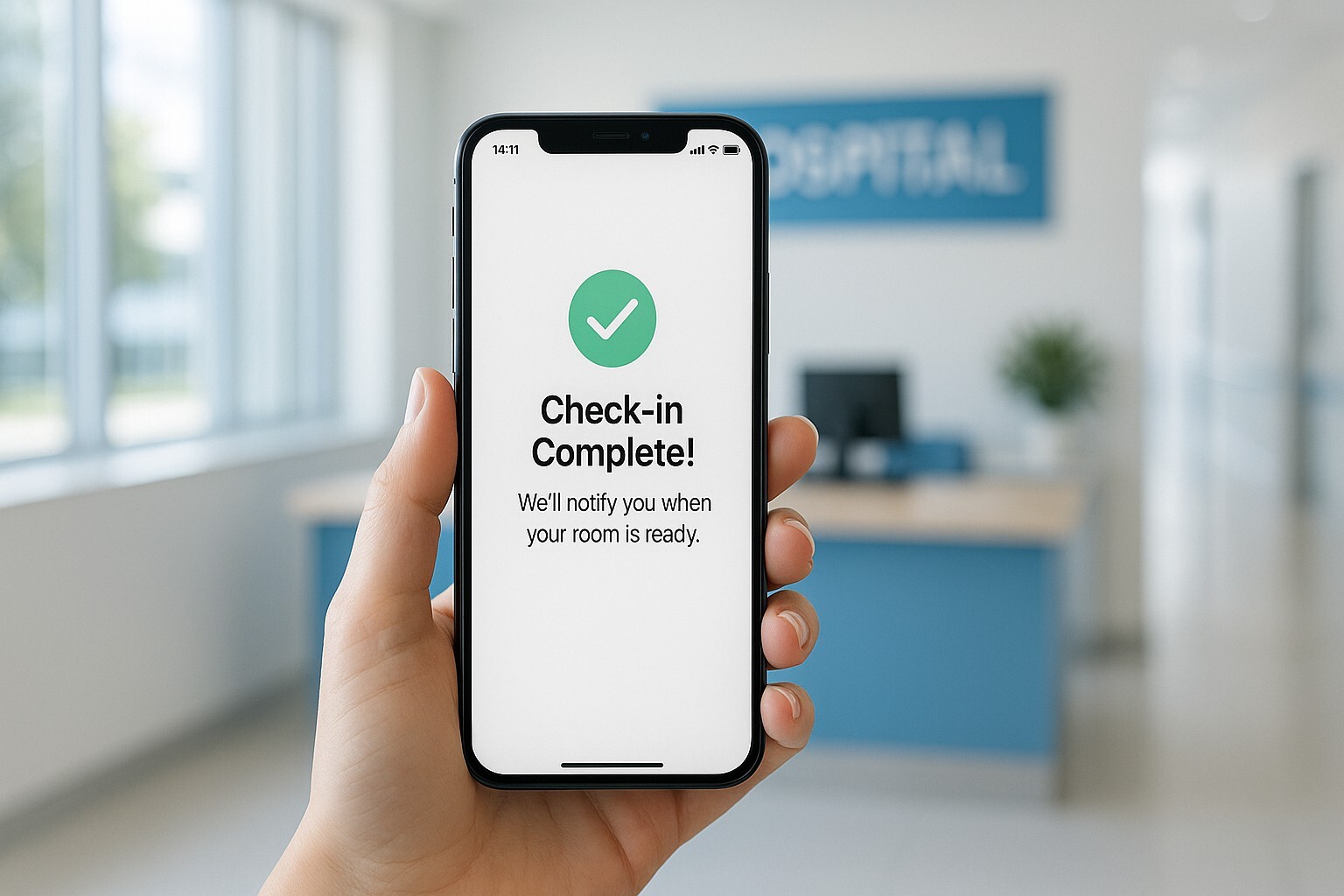11 Top Benefits of Digital Patient Check-in & Online Patient Check-in for Modern Practices
The modern patient expects convenience, speed, and digital-first experiences in every aspect of their lives—including their healthcare. A digital...
9 min read
Alvin Amoroso : 7/30/25 10:05 PM

The first few minutes a patient spends interacting with your practice can define their entire experience. A clunky, slow, and confusing medical check in process creates immediate friction, setting a negative tone before they even see a provider. Conversely, a smooth, efficient, and welcoming patient check in builds confidence, communicates respect for their time, and lays the foundation for high patient satisfaction and loyalty. In today's competitive healthcare landscape, optimizing your patient check-in procedure is not just an administrative task; it's a critical business strategy that directly impacts your clinic's reputation, operational efficiency, and bottom line. This guide provides nine actionable steps to transform your front-desk operations from a bottleneck into a powerful asset.
For decades, the standard patient check in involved a clipboard, a pen, and a long wait. Patients would arrive, often already anxious about their appointment, only to be met with a stack of paperwork and an indeterminate amount of time in a crowded waiting room. This outdated model is failing modern practices and patients alike. A streamlined medical check in is essential for several key reasons.
The check-in is the very first point of physical or digital contact a patient has with your clinic on the day of their appointment. This initial interaction frames their perception of your entire operation. A seamless process suggests that your clinic is modern, organized, and values their time. A chaotic one suggests the opposite, potentially making them question the quality of care they are about to receive. A positive first impression can ease patient anxiety and create a more collaborative and trusting patient-provider relationship from the outset.
Patient experience is a major driver of retention. Long wait times are consistently cited as one of the biggest complaints in healthcare. When you streamline the patient check-in procedure, you directly address this major pain point. Patients who can complete forms from home, verify their insurance automatically, and know their co-pay in advance feel empowered and respected. This positive experience is a significant factor in their decision to return to your practice for future care and to recommend your services to others. Satisfied patients are loyal patients, and loyalty is the bedrock of a sustainable practice.
Efficiency is profitability. A poorly managed medical check in is a drain on resources. Staff members spend valuable time deciphering handwriting, manually entering data, chasing down missing insurance information, and managing frustrated patients. This is time that could be spent on higher-value tasks.
Furthermore, an optimized system with features like automated insurance verification and digital co-pay collection drastically reduces billing errors and claim denials down the line. By ensuring all information is correct and payments are collected upfront, you improve your revenue cycle management, increase point-of-service collections, and decrease the administrative burden of post-visit billing corrections.
Your front desk staff are on the front lines. They bear the brunt of patient frustration when processes are slow and inefficient. A chaotic check-in environment leads to stress, burnout, and high turnover rates. By equipping your team with modern tools that automate repetitive tasks and empower patients to manage their own information, you create a more manageable and less stressful work environment. When staff can focus on welcoming patients and solving complex problems instead of just processing paperwork, their job satisfaction soars, which in turn leads to better patient interactions and a more positive clinic atmosphere for everyone.
A successful medical check in system isn't a single tool but an integrated process that begins before the patient even leaves their home. It’s a multi-stage approach designed to distribute the administrative workload and create a smooth, continuous flow from appointment booking to the moment the patient enters the exam room.
The most significant evolution in the patient check-in procedure is the shift to pre-arrival engagement. This "digital front door" allows the majority of administrative tasks to be completed at the patient's convenience.
This pre-arrival phase means that when the patient arrives, their medical check in can be as simple as stating their name.
While pre-arrival is ideal, you must accommodate patients who couldn't complete the steps or prefer to do it in person. The modern clinic offers a spectrum of options.
The patient check in doesn't end when the paperwork is done. The final component is managing the wait. Anxious waiting erodes the goodwill you've built. Modern systems integrate communication to keep patients informed.
Transforming your check-in process requires a strategic, step-by-step approach. Here are nine proven strategies to create a system that delights patients and empowers your staff.
This is the single most impactful change you can make. A digital pre-registration solution allows patients to handle the bulk of the medical check in paperwork from the comfort of their home. Look for a system that is mobile-first, as most patients will use their smartphones. It should seamlessly integrate with your existing Electronic Health Record (EHR) and Practice Management (PM) systems to ensure data flows directly into the patient's chart, eliminating manual data entry and potential errors. This step alone can cut patient time at the front desk by over 75%.
One size does not fit all. While many patients will embrace a fully digital patient check in, others may be less comfortable with technology or have specific questions. A truly patient-centric approach offers multiple pathways.
A common bottleneck in the patient check-in procedure is dealing with insurance issues. Manually calling insurers or navigating clunky portals is time-consuming and prone to delays. Implement a system that performs automated, real-time insurance eligibility and benefits verification when the appointment is booked and again 24-48 hours before the visit. This proactive approach identifies issues like inactive policies or high deductibles early, allowing your staff to resolve them with the patient before they arrive. This prevents last-minute surprises, reduces claim denials, and ensures you can accurately calculate the patient's financial responsibility.
Discussing money can be awkward. Integrating payment collection into the digital medical check in process normalizes and simplifies it. When a patient can see their co-pay or outstanding balance clearly listed and pay it with a credit card or digital wallet during pre-registration or at a kiosk, it becomes a simple, transparent transaction. This dramatically increases point-of-service collections, improves your cash flow, and removes a common point of friction between staff and patients. For a more robust system, consider offering payment plans through your portal, such as our text-to-pay solution.
Technology can’t completely eliminate waiting. Therefore, you must optimize the physical environment. Start with clear, simple signage directing patients to the appropriate check-in option (kiosk, front desk). Ensure your Wi-Fi is fast, free, and easy to access. Provide comfortable seating with charging stations for mobile devices. Consider a digital display that shows real-time, anonymized queue information. A calm, comfortable, and informative environment significantly reduces the perceived wait time and lowers patient anxiety.
A new system is only as good as the team using it. Invest heavily in training your front-desk staff. They need to be experts not only on how the technology works but also on how to troubleshoot common issues and assist patients who are struggling. Develop a clear, written Standard Operating Procedure (SOP) for the new patient check-in procedure. This document should outline how to handle every scenario, from a patient who completed pre-registration to one who walks in with no appointment. Empowered and well-trained staff will become champions of the new system, ensuring a smooth rollout and successful adoption.
When you implement a digital patient check in, you are handling a vast amount of Protected Health Information (PHI). Patients need to trust that their data is secure. Your chosen technology vendor must be fully HIPAA compliant, with features like end-to-end data encryption, secure cloud storage, and detailed audit trails. It's crucial to be transparent about these security measures. You can include a short statement on your digital forms and website explaining how you protect patient data. For more information on your obligations, refer to the official guidance on the Health Information Privacy page from HHS.gov. This commitment to security is a critical part of building patient trust in your digital tools.
Your new system is live, but the work isn't done. The final step is to create a feedback loop for continuous improvement. Use automated post-appointment surveys (sent via text or email) to ask patients specific questions about their medical check in experience.
Efficiency shouldn't come at the cost of humanity. Use the data you've gathered to personalize the experience. If a patient has pre-registered, the system or staff member can greet them by name ("Welcome back, Sarah! We have you all checked in.") instead of asking for their date of birth. The system can remember a patient's preferred language or communication method. These small touches of personalization show the patient that they are not just another number in a queue but a valued individual. This psychological component of being seen and acknowledged is incredibly powerful in building lasting patient relationships. To learn more about how our tools can facilitate this, check out our patient engagement solutions.
To justify the investment in a new system, you need to track its impact. Focus on a few Key Performance Indicators (KPIs) to measure the success of your optimized patient check-in procedure.
A "medical check" is a broad term that generally refers to the process of a patient being examined by a healthcare provider. It can range from a routine annual physical to a specific visit for an acute illness or injury. The medical check in is the administrative and clinical intake process that occurs just before this examination, where information is gathered, vitals may be taken, and paperwork is completed.
A typical patient check in involves several key steps. The patient first identifies themselves to the front desk staff or a digital system. They then verify or provide their demographic information (name, address, phone number), insurance details, and medical history. This often involves filling out forms (either on paper or digitally). They may also be asked to present a photo ID and insurance card, sign consent forms, and pay any required co-pay or outstanding balance. Once these tasks are complete, they are considered "checked in" and will wait to be called for their appointment.
A routine medical check-up, often called an annual physical or a wellness visit, is a preventative appointment with your primary care provider. The goal is not to address a specific illness but to assess your overall health, identify potential risks for future problems, and encourage healthy lifestyle choices. It typically includes checking vital signs (blood pressure, heart rate, temperature), a physical exam, a review of your medical and family history, and screenings for common conditions like high cholesterol or diabetes.
A "full medical check up" is a more comprehensive version of a routine check-up. While the term can vary, it generally implies a more thorough battery of tests and screenings based on the patient's age, gender, and risk factors. In addition to the components of a routine check-up, a full check-up might include extensive blood work (like a complete blood count and metabolic panel), a urinalysis, an electrocardiogram (ECG) to check heart health, and screenings for specific types of cancer. It is a deep dive into a person's current health status, designed to catch any potential issues as early as possible.

The modern patient expects convenience, speed, and digital-first experiences in every aspect of their lives—including their healthcare. A digital...

The single biggest opportunity to reduce staff workload and improve patient satisfaction lies in the first five minutes of a patient's visit. A...

A contactless patient check-in system allows patients to complete registration, forms, and payments from their own device before arriving,...